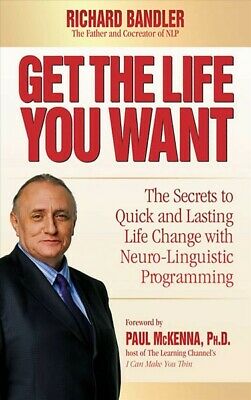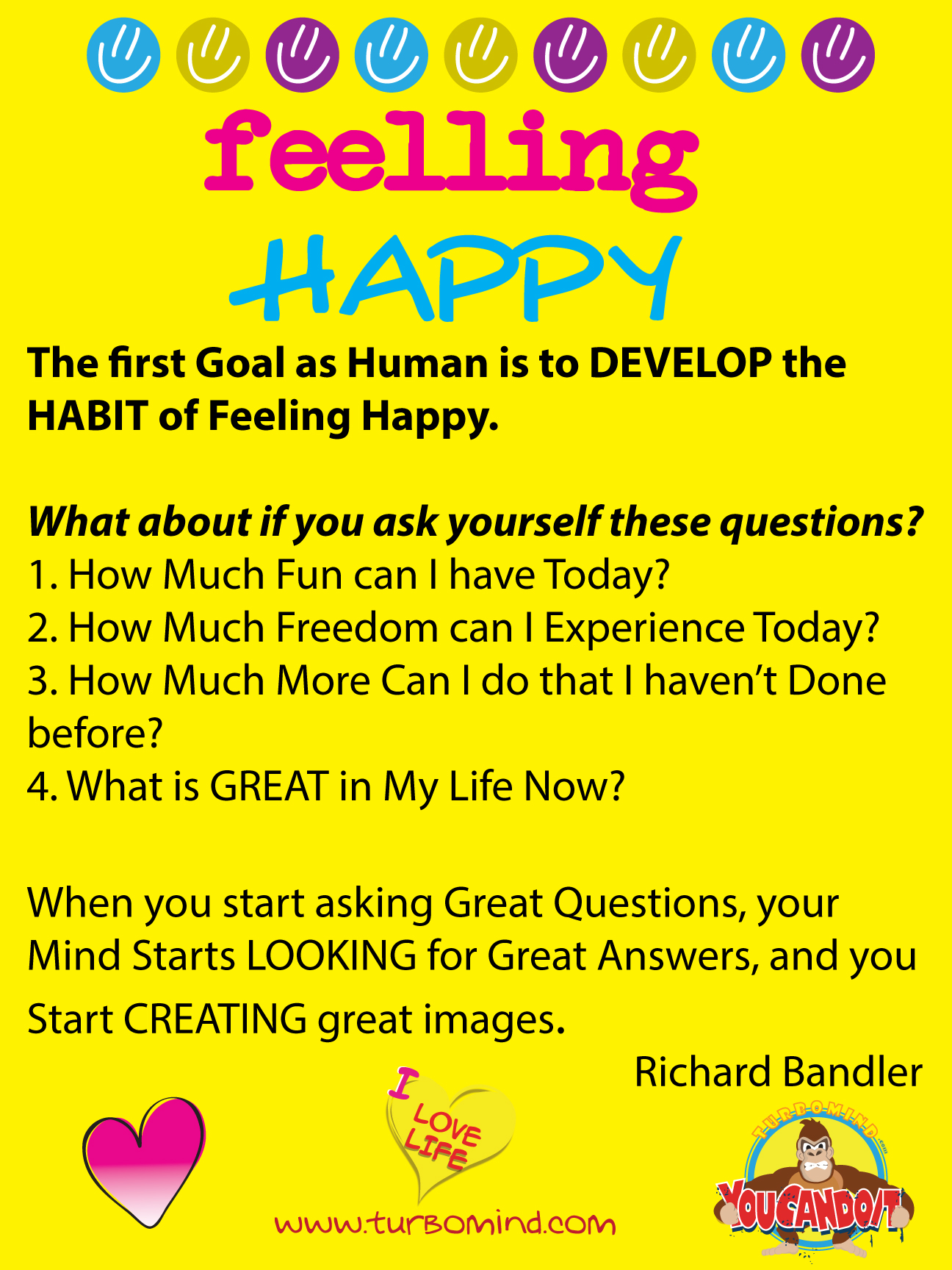

“Get the Life You Want”, by Richard Bandler, TURBOMIND Book Summary and Discussion by Tylor Jones. The secrets to Quick and Lasting Life Change with Neuro-Linguistic Programming. https://www.turbomind.com/.
You can buy the book here: https://www.amazon.com/Get-Life-You-Want-Neuro-Linguistic/dp/0757307760
Visit Richard here: https://richardbandler.com/
by Tylor Jones, Master Coach
Contact me Through WhatsApp or Telegram for a 30-Minute Free Coaching Session. I love helping people and Businesses become Exceptional. Whatsapp at +507-6426-9450
————————–
Hi, this week´s TURBOMIND´S book is “Get the Life You Want”, by Richard Bandler. One of my Favorites for personal transformation.
This is not a summary. It’s more like a deep and practical essay for the book as well as some of the best up-to-date Neurolinguistics’ techniques.
Richard Bandler was the co-founder and co-creator of NeuroLinguistic Programming, as well as “Design Human Engineer” and “Neuro-Hypnotic Patterning”
One of the main focus of Richard has been to help people achieve what he calls “PERSONAL FREEDOM” which means being able to control your thoughts, your emotions, and create the feelings you want in your life.
There are coaches, there are trainers, there are experts, and then, there is Richard. You can love him or hate him, but he is the master of what he does. He is one of the BEST in the world at what he does. He also has trained some of the best coaches in the world.
He is one of the best in the world at curing phobias in record time. In most cases, he can do it in one session of 30-minutes because he teaches people HOW TO THINK about their fears in a NEW WAY. This whole book is about teaching people to think differently.
While most therapist try to look for the cause of the fear, phobia or obsession, to be able to understand it, believing it would help solve them, Richard Bandler helps them do things differently in the present, by working with what’s going on inside their minds.
Understanding the problem by itself doesn’t produce change. Any compulsion doesn’t function in the past; it functions in the present moment.
When people are good spellers, it turns out that they make pictures of the words, remember the pictures and check them with their feelings to make sure they are right.
The main message of this extraordinary book is that You can learn to get over your problems, but it takes determination and commitment to do so.The number or people who, every year, give up on diets, on learning languages, on relationships, on businesses, on anything, is astronomical. You need to plan for difficulties, so when they appear you are prepared.
You can reach Richard at https://richardbandler.com/.


————————————————
HUMANS ACQUIRE PROBLEMS VERY EASY
We humans acquire problems very quickly, meaning we make it very easy to acquire a problem, a phobia. People learn to have phobias very quickly. You only need to take one big turbulent airplane ride to develop one.
So, if we learn to have a phobia so quickly and easy, WHY NOT TO ABLE TO to learn to take it out as quick as you did in the first place.
This is the fascinating proposition of this book as well as the whole neurolinguistic programing strategies.
And this is the premise: with the right tools you can take a phobia out as fast as you got it in the first place.
————————————–
HOW YOU “KEEP DOING” THE SAME PROBLEM
The psychoanalytical approach of going back in time and relieving traumas was based on the idea that insight produces change, but it doesn’t. It helps you understand but it doesn’t change behavioral patterns. You understand you have a problem, and what caused it but you don’t get away from it.
The only thing you need to understand when you have a problem is HOW YOU KEEP BEING THAT WAY. And HOW YOU CAN STOP DOING.
If you wake up every day and ask yourself, “What can go wrong today?”, an answer will come up, and automatically you will create the corresponding image. Probably a catastrophic one.
If you look for difficulties, you will find them.
What is fascinating is most people think and live that way without being conscious of it.
——————————————-
FIRST GOAL IS TO FEEL HAPPY
The first goal as human is to develop the habit of feeling happy.
What about if you ask yourself these questions?
–How much FUN can I have today?
–How Much FREEDOM can I experience today?
–How much MORE can I do that I haven’t done before?
-What is GREAT in my life now?
When you start asking great questions, your mind start looking for great answers, and you start CREATING great images. It’s fascinating.
When Richard asked psychiatrics to name some of the biggest problems they faced, they would usually mentioned phobias. So, he started studying how to help people with phobias.
When he studied phobias he didn’t focus on them. He studied people who got over them. He found many people who got over their phobias without any therapy. These people have beaten and overcome their fears.
He studied some of the MOST SUCCESSFUL THERAPIST of the time and created a model for their skill. This is known as the Meta-Model.
Basically, the Meta-Model is a way for finding out how people process information. Not in the past, or the future, but how they are processing information right now.


—————————————————
THE META-MODEL
So, in the Meta-Model, you ask questions like these:
(regardless of their fear, from fear of elevators, snakes, Planes, heights, public speaking)
–How do they manifest their fear?
–How is it done as an activity?
-How is it done as an activity over and over?
-How did they get over their fear?
-What steps did they take to overcome their phobia after being paralyzed for years?
Some of them reached a point that they were so fed up they stop thinking about it. Which by the way is a little silly.
At that point, therapist he worked with sent him droves of people with all types of phobias so he tested his new techniques with them.
Richard started doing installations, that is teaching people to think differently. THINKING should be done in a way that BRINGS you the results you WANT.
—————————————————-
ENCODING IMAGES
When people are good spellers, it turns out that they make pictures of the words, remember the pictures and check them with their feelings to make sure they are right
When you see the word, you can encode the image of it. In order to remember something, you first have to encode the memory. If you teach someone to properly encode the spelling of a word, they will be able to properly decode the spelling of words. The same is true for all memories.
———————————————————
We have the freedom to live, to be happy, and to use your potential.
Richard believes that most ongoing problems are just a manifestation of having the SAME BAD HABIT OVER AND OVER.
People who have obsessive compulsive disorder have the habit of repeating rituals to try to turn away their anxiety. These rituals may give them a little comfort, but in the end, it continues to build more fear.
You can learn to get over your problems. You can have more freedom, and you can become the best person you can be.
The phobia will come back when you start doing the same things you did when you have it as well as thinking the same way you were thinking. If you don’t go back to those behaviors, it won’t come back.
—————————————————
THE POWER OF YOUR UNCONSCIOUS:
Your conscious is the part of your mind that analyzes, criticizes and thinks logically. It´s where you put your attention.
The unconscious part controls your heartbeat, bodily functions, breathing and other automatic processes.
When you are sleeping, your conscious part is resting and your unconscious takes over.
Most of his life, Richard has devoted to helping people change their unconscious habits and skills so they can make profound changes in their lives. Many times this was done with the help of hypnosis.
A trance helps you directly to speak to your unconscious. That’s how Milton H. Erickson produced extraordinary changes in his patients.
One if the most important discoveries Richard made was that it´s possible to help people make changes without having to hypnotize them.
Most people don’t have a problem getting into trance, their problem is getting out of the trance they are living in because they are living in dis-empowering states, making stupid decisions, thinking stupid thoughts.
Trance is an everyday phenomenon. You don’t need to be hypnotized to be in trance.
—————————————-
UNDERSTANDING SUB-MODALITIES
This is one of the MOST POWERFUL tools to help people make changes.
People build Mental Representations.
Thinking can be done in different ways: thinking in PICTURES, thinking in WORDS, and thinking in FEELINGS, TASTES AND SMELLS.
The qualities of the images, sounds and feelings are known as sub-modalities.
When you get a direction from someone or you give directions to someone on how to get somewhere, you rely on your own ability to go inside and mentally represent through a movie how to get there.
When people create something, they must create it first in their minds by imagining what this something will look like.
EXERCISE:
Go through what you did yesterday, from the beginning of the day to the end. You might think in still images or you might make it into a movie that runs continually. THIS IS ONE WAY HOW YOU PROCESS YOUR EXPERIENCES FROM THE WORLD.
When we think of something, the picture you create are located in a specific place in your mental screen. These pictures also have a particular size, with a particular distance.
You either see yourself in the image, meaning you are disassociated, or you are looking through your own eyes, as if you are there, meaning you are associated.
-Where the image is located on your mental screen
-the size of this image-
-The Distance of the image
-Internal sound, hearing the message with your own voice another sound.
-You looking from outside or being inside it.
——————————————-
THE VOICES IN YOUR HEAD
When hearing a mental voice inside your head, it can be YOUR own voice or someone else’s voice. It’s usually on the right or on the left. It’s either going in or going out.
Some voices are very loud, others very quiet. Different states produce difference voices.
——————————————
THE LOCATION OF YOUR FEELINGS
The same thing happens with feelings. When you feel something you can feel it in your body in a particular location. We can feel it starting somewhere in your body and move to another location when you pay attention to it.
When people talk about fear, people say things like, “I felt butterflies in the pitch of my stomach and then my mouth went dry and I felt lightheaded”
People are constantly revealing what is going on inside of them.
When Richard started watching all kinds of counselors, therapists and psychiatrists working with patients he was amazed how they would ask, “Well, how do you feel about that”, and they would have answered, “I feel frustrated”.
They would ask the same question over and over WITHOUT finding out what that meant to them.
They would have failed to see the word that had been turned into an event, it was something the person was DOING.
When people say they are frustrated, it’s actually a VERB. When people say I have doubts”, they have turned the verb into a NOUN and made it so it becomes an EVENT or a THING.
When people say “I have frustration”, they don’t have a suitcase full of frustration. They are in the process of being frustrated, which is an ACTIVITY, therefore, they are DOING FRUSTRATION.
Therefore, YOU ARE NOT DEPRESSED, YOU ARE DOING DEPRESSION that will take you to being depressed.
So, when you are asking “how do you feel about that?”, you are missing on much more important questions like: “What do you mean?”, or
“How do you represent it?”, or
“Where do you feel it?”,
“where do you feel frustrated?”,
“Where does the feeling start?”.
FEELINGS CAN´T STAY STILL. THEY ARE ALWAYS MOVING SOMEWHERE IN SOME DIRECTION.
The more information they give you, the more you can help them by helping themselves.
The endemic brain tells us that the connection between all organs is deeply sophisticated, and as sophisticated as the synapses inside the brain and actually allows you to think in feelings.
Our bodies are deeply connected to our brains. Actually, they are an extended part of the brain.
When people feel fear, they usually feel a knot stuck in their gut, but this knot does not stay still. It either rotates forward or rotates backwards.
It doesn’t matter where you feel it. What’s important is what you do with it.
The fact that is moving is important because you can move it forward, slower, faster, backward which means YOUR FEELING IS UNDER YOUR CONTROL.
This is the most important thing you can control because, when you do, you can change your feelings.
Some people have a hard time knowing which way their feelings are moving, so they can put their hand on their stomach or chest and get idea of the direction.
————————————————-
CHANGING YOUR BIOCHEMISTRY
One of the main focus of Richard has been to help people achieve what he calls “personal freedom” which means being able to control your thoughts, your emotions, and create the feelings you want in your life.
Often we are chained to our own dis-empowering thoughts and destructive patters and allow ourselves to think into problems.
The great news is since most problems in our lives are imaginary, we can implement imaginary solutions.
—————————————————————-
Feeling Good Exercise
- Think of a time when you felt really good. Step inside that time and see through your eyes, hear through your hears, and feel those great feelings all over your body. Remember this time in detail. Remember the sounds, the images, the feelings, as much as you can. Stay there for a couple of minutes. As you keep repeating this exercise, you will be able to remember more details about this time when you felt really good. If you keep doing it, you will be able to anchor this time and the corresponding feeling. You can do this with a memory of an event or with a imaginary event, in other words, visualizing something you want to happen or a feeling you have to have.
- NEXT, make the sounds louder, and crisper. Make the images bigger, brighter, and more colorful, with more detail, and you probably will intensify these good feelings.
- Next, find out where in your body this feeling starts and where it goes. Discover the direction it spins inside your body and spin it faster and notice your feelings again. Imagine taking control of your feeling and doing whatever you want with it.
- Think of a time in the future you can use these feelings. Spin these feelings along your body as you think about the future as well as the things you will be doing in the next few weeks. Propel these good feeling into your near future.
——————————————————-
CHANGING “A BAD FEELING” EXERCISE
- Think about someone you don’t like, irritates or annoys you. Make an image of this person and have this person look at you in whatever way he looks at you when you feel irritated or annoyed.
- Take this image and make it white and black. Move it far away in the distance. Make it smaller, much smaller.
- Hear this person say whatever he usually says, but change the voice to Mickey Mouse, Silvestre the Cats voice, or just distortion the voice you can’t even understand whet he is saying.
- Now notice how you feel. Probably you will feel differently. Do something else, and go back and do it again and again until you change the feelings.
———————————————
BELIEFS: CREATING CERTAINTY
Beliefs are what trap most people in their problems. Beliefs can be the chains or the propellers. Your beliefs refer to a sense of certainty on some of your thoughts.
Unless you truly believe you can get over something, get through something or get to something, there is very little probabilities this you will be able to do this “something”.
Most people learn a lot of limitations form their parents and authority figures.
As soon as you believe something, you SEARCH FOR WAYS to prove it´s true.
It´s better to learn to doubt your limitations and be more certain of what’s truly possible for you.
If you are going to doubt something, why not doubt your limitations?
Like a thought, a belief has a structure in terms of their qualities.
Ask yourself this question, do you believe the sun will come out tomorrow? In order to answer this question, you will represent this belief in your mind.
When you ask yourself this question, your mind will flash an image of the answer, or listen to a voice, or have a feeling about it.
You have a mental and physical pattern of that belief.
-Where is that picture in your mental screen? Is it to the right or to the left? How far away is it? Is life size, bigger or smaller? Is it a still picture or moving?
Does it have any sound? Is there a voice that yes? Is there anything else going inside?
-Now think of something that you doubt or you are not sure.
-Notice the images, sounds and feelings that arise.
-Notice the differences between the strong belief, and one of uncertainty. This is the way your brain represents a strong belief versus uncertainty.
-Choose something you are not sure about and change to the strong belief sub modalities.
When people suffer mentally they usually do it by feeling bad about the past, feeling stuck in the present situation or feeling scare or worried about the future.
We use terms like:
-getting over…..
-put things behind us…..
-getting through what’s in front..
-getting to……
-looking forward to our future….
———————————————
TIMELINE, HOW YOU MENTALLY CODE TIME
Time lines refer to your own ability to code time. When we think about time, we think in certain ways. Usually the image from the past are in different places than the ones about the future.
When you think of an image from the past and one for the future you can draw an imaginary line between them.
Think about exercising 5 years ago, then think about exercising 1 years ago. Notice where the images are located in your mental space. Think about exercising today.
In time: you see your future in front of you, your past behind you and your present inside of you.
Through time: past is on your left, the present in front of you and your future to your right.
The difference where you locate them is usually the difference how you approach time.
Dram an imaginary line from your past into the future. This is your time line.
————————————————–
GETTING OVER BAD SUGGESTIONS:
A great question you can ask people is, “how do you know X?”, for example, someone tells you she feels nervous, “How do you know you feel nervous?”
You can elicit the strategies this person uses to get nervous.
EXERCISE:
- Think of someone negative someone has told you or something bad you said to yourself.
- Think of someone you distrust who has said a lie and remember how they said that lie.
- Notice the sub-modalities of the lie and the negative suggestions
- Move the negative suggestions into the sub-modalities of the lie and snap it into place so you think about the suggestion in the same way as the lie.
BETTER SUGGESTION EXERCISE:
- Think of an empowering suggestion you want to believe
- Imagine yourself going back in your time line when you were very young and imagine hearing someone who you really believed, saying this empowering suggestion about you. Hear this suggestion in your head.
- Imagine yourself going through your time line, through the years with this powerful belief about yourself and notice how different you feel with this new belief.
——————————————-
GETTING OVER FEARS AND PHOBIAS
One of the biggest challenge people have is getting over fears and phobias. Fear is not necessarily a bad thing. Fear moves you away from things.
Phobic fears happen when you see something and immediately you are invaded with fear. Anxiety is more a gradual, build-up of fear.
What is fascinating is people think they are afraid of objects, or elevators, or snakes, or heights, but in reality it’s not the height that makes you afraid, it’s your own brain.
So, the focus is, what is the person doing inside their own head that is making them afraid? that is a great question.
What type of images are they creating for this to happen? What are they telling themselves about this?
On the other side, and just as important as the other questions, are these:
What is the person who feels calm and confident in those situations telling themselves and doing inside their hear?
REMEMBER, THE KEY TO DEVELOP A WINNING STRATEGY IS TO STUDY THOSE PEOPLE THAT ARE WINING, WHAT ARE THEY DOING.
After interviewing 100s of people who got over height phobias, he saw a common pattern; they all reached the point where they got fed up with being afraid.
Start looking at your fears not as an independent event, but as a continuous chain of events, back to back. It builds up your disgust. Pick up 5 episodes where you were afraid and put them together in your mind. Make the pictures bigger, with more color, see yourself in these memories. Come to the point where you tell yourself that this is absurd. “Enough is enough”. Need to come to that point.


——————————————-
FAST PHOBIA CURE EXERCISE
- Think about something you fear deeply, a phobia. Think of a time you experienced this intense fear (it can also be an imaginary situation)
- Imagine yourself in a movie theater, watching yourself in the screen going through the experience.
- Imagine yourself being in the projector booth of that theater. You are looking down at yourself going through the experience.
- Run the movie to the end very you have survived the experience and then imagine floating inside of yourself at the end of the movie.
- As you are inside yourself after the scary movie, imagine running the movie backwards. You are walking, talking and doing everything backwards. While you do this you hear a circus music in your mind along this movie. Think of the phobia and notice how you feel now.
- Repeat these steps 7 times.
- Notice the difference.
People say one day you will look back and laugh at your problems. The thing is, why wait? Whay not do it now?
——————————————-
IF SOME DAY YOU ARE GOING TO LOOK BACK AT YOUR PROBEMS AND LAUGH, WHY NOT DO IT NOW? Wouldn’t be nice to have a day off from your problems?
LAUGH AWAY FEARS EXERCISE:
- Think of a time when you laugh your head off, and it was impossible to stop. Remember how you felt, and what you were thinking and doing.
- Start chuckling to yourself as yourself until you are laughing continuously.
- As you do this start thinking of the thing you fear.
- Notice how you feel and how the sub-modalities of the fear change.
———————————
FEAR OF PUBLIC SPEAKING:
Public speaking is the single biggest fear people have.
In order to get rid of your fear of public speaking, you have to listen to yourself talk so you know what you´re are saying.
People with fear of public speaking focus to much on themselves and not enough on what’s going on in the room. Watch the reactions you are getting.
When it comes to most fears, the common denominator is people not paying attention to the experience. If you pay attention to the people in front of you breathing in and out, and listening to your voice, you will feel differently.
Fears have always to be replaced WITH SENSORY ACUITY. They also can be deal with by taking control of the fear feeling itself.
It’s easy to be afraid if you are thinking about the fear-pictures you are making in your head and you are spinning them out of control.
Use the same technique to spin your goals out of control.
Ask yourself these questions, when you know you going to have to speak in public,
-Where does you fear start?
-Where do you feel your fear?
-Is spinning to the right, left, backwards, forward?
What is interesting, sometimes people are so afraid, they have a hard time identifying and describing the fear itself. It’s a great technique to have them take their finger, hold it to the side and rotate it in several different ways to recognize how is the fear operating.
Once you know how the fear is working, you can take control by playing with it, rotating faster, in different directions, change colors of the spinning, etc. The key is to take control of it so that you interfere with the way it’s working.
As soon as you start to spin it backwards, they are no longer fears because it changes the feeling itself.
As long as you maintain the spinning direction, and spin it faster and faster, all of a sudden, the brain, STARTS DECODING THE EXPERIENCE. And when you try to go back into your fear you realize you have a hard time doing it because there has been a shift in how the experience is decoded and felt.
————————————–
REVERSING ANXIETY, (Neuro-Hypnotic Repatterning)
- Think of something makes you be afraid, or anxious
- Notice the direction the anxiety spins in your body, and visualize it seeing red arrows which point whatever way it moves.
- Imagine taking the feeling out of your body, changing the arrows from red to blue, changing the direction of the spinning, so it spins in the opposite direction and with blue color.
- Keep spinning the feeling faster and faster in the opposite direction and notice how you feel.
- Think of something that makes you feel really comfortable. Notice the direction the feeling spins.
- Spin this comfortable feeling as you imagine the experience going on.
- As you do this, look at what you can see in front of you in the present moment, as well as all the things you can pay attention in the real world now.
———————————————
GETTING THROUGH HABITS AND COMPULSIONS:
Habits are simply what get used to do automatically. Compulsions refer to what you are compelled to do. There is an overlap between the two of them.
When people come to Richard and tell him, “I am suffering from anxiety”, he asks them, “Are you sure?”. What is amazing is how people who supposedly have great uncertainty can be so sure about their fears.
There is always a place where these things overlap and start to self-destruct.
It’s like when we have a bad habit we seem to find a way out, by engaging in what it’s called “Fudge factor”, where our minds find a way of getting out of what we know we must do.
Without mental preparation bad habits are hard to break.
After people try to break them without success, the failures start stacking up and makes it even more difficult because they build up the belief that they will never be able to succeed.
And when you develop this belief, it’s unlikely you will change or achieve anything, regardless how much you want it.
YOU NEED TO BUILD BELIEFS ABOUT WHAT´S POSSIBLE IN YOUR LIFE.
When you are trying to quit smoking the number one priority is build the belief that you´ll be able to quit.
EXERCISE
- Think about whatever triggers make you want something you want to stop.
- Imagine the movie and white it out.
- Replace the image quickly with one that you engage in new behavior, looking great, powerful, excited.
- Replace steps 1.3.
——————————————-
RECOVERY
It’s amazing how people who supposed they want to help and support you can install a belief that you´ll never be able to recover from whatever illness you are suffering.
There is a great support idea Richard received when he had a stroke some years ago, this is what medical doctor told him:
“No matter what anyone says to you, no matter who they are, I am telling you, you can make a FULL recovery”
What a beautiful soul, and what an awesome hypnotic suggestion to neutralize the negative suggestions that he probably would receive being there.
It’s amazing what a great suggestion from a loving person can do for you.
No one can predict the future. No one can tell you what you can´t do.


—————————————————————
SUMMARY
You deserve to have a good life. And these techniques and strategies help you to do that, to take control of your mind, reduce and eliminate unnecessary fears and live the best you can.
Your brain runs all the time without resting. It will run in the direction you want it to run, or on another direction. You have to power to control and direct your own brain. Just by Manipulating and changing the images and sounds inside your head changes the way you feel.
As we talk to ourselves, we are also creating images simultaneously.
These strategies are quick ways to make quick changes. The help you rewire your neurology so you feel differently.
If you don’t control your thoughts, and the pictures you make, most likely you won’t feel as good as you could. It will control you, most likely with fear and chaos.
Sometime ago people would compare something that was impossible to putting a man on the moon. However, shortly, there was a man on the moon and that example was obsolete.
Most of what we see today was an impossibility sometime in the past.
When you put all your resources into completing an important task, project or mission, often incredible things happen. When you put yourself big goals, weather you achieve them or not, amazing things tend to happen.
Practice these techniques you help you free yourself from the chains of fear and become the best you are capable of becoming.
No matter what anyone says, no matter who they are, no matter where they are from or how many titles or PHDs they have, you can achieve your greatest and most extraordinary dreams and desires. No one can predict the future. No one can tell you, you can´t do something.
It might require to push yourself harder than anyone else does.
When people tell you “don´t be discourage, don’t be disappointed” they are getting you ready for exactly that, to be disappointed. It’s like “don’t think of a pink elephant”. It creates polarity.
The more people tell you that you can´t do something, the more you are motivated to do it.
This is when you need absolutely, overwhelming determination and resolve that turns itself into a behavior. The more difficult things get, the more you need to apply yourself. Most of the people who become great geniuses had this mindset and behavior built in since they were young.
When Richard started, it was amazing how many people would tell him it couldn´t be done, how many therapist, psychologists, psychiatric, would predict he would not be able to help people with phobias using these approaches.
All these people, who couldn’t do it themselves would tell him over and over that it couldn’t be done, even without knowing which person he was going to work with.
These prophets of doom are the ones who also said not to try so hard, not as hard as you possibly could.
As Richard says, “When you become fully determined, and when you only measure the degree of success that you get, you will be amazed at what’s possible”.
Measure what you are succeeding at.


——————————————————
IMPORTANT POINTS
- Understanding the problem by itself doesn’t produce change. Any compulsion doesn’t function in the past; it functions in the present moment.
- If YOU CAN learn to have a phobia so quickly and easy, why not be able to learn to take it out as quick as you did in the first place. It only takes one bad plane trip to create a phobia.
- You are not depressed; you are doing depression. You need to do the activity in order to get the results. To become depressed, you have to do depression, things you do in your mind, pictures, what you are telling yourself and how you use your body.
- If you want to be successful at anything the easiest way is to learn about those who are being successful. Richard studied some of the most successful therapist of the time and created a model for their skill. This is known as the meta-model.
- Thinking can be done in different ways: thinking in PICTURES, thinking in WORDS, and thinking in FEELINGS, TASTES AND SMELLS.
The qualities of the images, sounds and feelings are known as sub modalities
————————————————–
GREAT QUOTES
- Beliefs are what trap most people in their problems
- I CAN TURN A LITTLE ACORN INTO A MASSIVE OAK.
- THE ONLY THING THAT STOPS MOST PEOPLE IS A LACK OF BELIEF THEY CAN DO SOMETHING SIMPLE.
- Find people who have succeeded and let them be your advisors.
- Most of what we see today was an impossibility sometime in the past.
- IF SOME DAY YOU ARE GOING TO LOOK BACK AT YOUR PROBLEMS AND LAUGH, WHY NOT DO IT NOW? Why wait?
- Wouldn’t be nice to have a day off from your problems?
- You deserve to have a good life
- “No matter what anyone says to you, no matter who they are, I am telling you, you can make a FULL recovery”
- No one can predict the future. No one can tell you what you can´t do.
- “When you become fully determined, and when you only measure the degree of success that you get, you will be amazed at what’s possible”.
- You need to plan for difficulties, so when they appear you are prepared.
————————————————
MY FAVORITE BOOKS ON WINNING
If you are looking for other exceptional books on mental training as well as mental toughness here are my favorites, the ones I have personally read:
- How Champions think by Dr Bob Rotella, https://www.turbomind.com/how-champions-think-by-dr-bob-rotella/
- An IRON WILL, by Orison Swet Mardin, https://www.turbomind.com/an-iron-will-what-all-great-men-have-in-comon/
- The Champion´s Mind, by Jim Afremov.
- With winning in Mind, by Lanny Bassham, https://www.turbomind.com/with-winning-in-mind-by-lanny-bassham/
- Chasing Excellence, by Ben Bergeron, https://www.turbomind.com/chasing-excellence-by-ben-bergeron/
- Mind Gym, by Gary Mack, https://www.turbomind.com/mind-gym-gary-mack-turbomind-book-club/
- Tom Coughlin, by him, https://www.turbomind.com/tom-coughlin-earn-the-right-to-win-best-ideas/
- No Limits, by Michael Phelps, https://www.turbomind.com/no-limits-by-michael-phelps-the-will-to-succeed-turbomind-com-book-club/
- Relentless by Tim Grover, https://www.turbomind.com/relentless-from-good-to-great-to-unstoppable-by-tim-s-grover-summary-by-miguel-de-la-fuente/
- Unbeatable Mind, by Mark Divine, https://www.turbomind.com/unbeatable-mind-mark-divine-turbomind-com-bookclub/
- Get the Life You Want, by Richard Bandler.
- Can´t Hurt Me, by David Goggins, https://www.turbomind.com/cant-hurt-me-by-david-goggins-turbomind-book-club/
- Make Your Bed, by Admiral William H- McRaven, https://www.turbomind.com/make-your-bed-by-admiral-william-h-mcraven-turbomind-bookclub/
- The 10X Rule by Grant Cardone, https://www.turbomind.com/the-10x-rule-the-difference-between-success-and-failure-book-summary/
- Discipline Equals Freedom. Jocko Willink, https://www.turbomind.com/discipline-equals-freedom-by-jocko-willink/
- RAFA, by Rafael Nadal, https://www.turbomind.com/rafa-by-rafael-nadalbook-summary/
- How to Win by Mark Cuban,https://www.turbomind.com/how-to-win-by-mark-cuban-book-discussion/
I keep updating this list regularly….
by Tylor Jones, Master Coach
Contact me Through WhatsApp or Telegram for a 30-Minute Free Coaching Session. I love helping people and Businesses become Exceptional. Whatsapp at +507-6426-9450






Facebook Comments